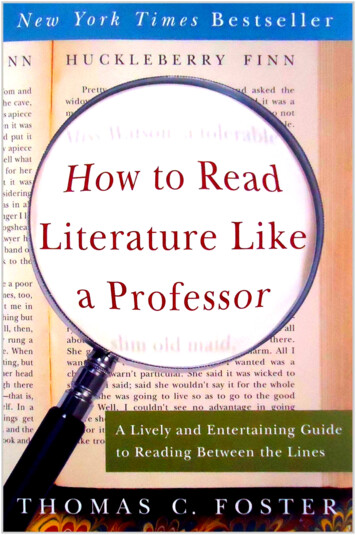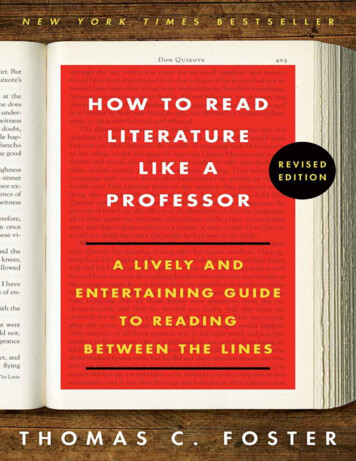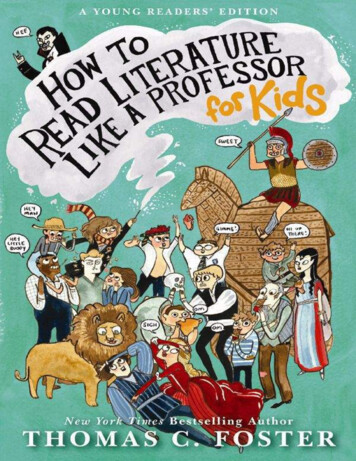
Transcription
How to Read Literature Like a Professor:A Lively and Entertaining Guide to Reading Between the LinesBy THOMAS C. FOSTERContentsINTRODUCTION: How’d He Do That?1. Every Trip Is a Quest (Except When It’s Not)2. Nice to Eat with You: Acts of Communion3. Nice to Eat You: Acts of Vampires4. If It’s Square, It’s a Sonnet5. Now, Where Have I Seen Her Before?6. When in Doubt, It’s from Shakespeare.7. .Or the Bible8. Hanseldee and Greteldum9. It’s Greek to Me10. It’s More Than Just Rain or SnowINTERLUDE Does He Mean That?11. .More Than It’s Gonna Hurt You: Concerning Violence12. Is That a Symbol?13. It’s All Political14. Yes, She’s a Christ Figure, Too15. Flights of Fancy16. It’s All About Sex.17. .Except Sex18. If She Comes Up, It’s Baptism19. Geography Matters.20. .So Does SeasonINTERLUDE One Story21. Marked for Greatness22. He’s Blind for a Reason, You Know23. It’s Never Just Heart Disease.24. .And Rarely Just Illness25. Don’t Read with Your Eyes26. Is He Serious? And Other Ironies27. A Test CaseENVOIAPPENDIX Reading List
Introduction: How’d He Do That?MR. LINDNER? THAT MILQUETOAST?Right. Mr. Lindner the milquetoast. So what did you think the devil would look like? If he were red witha tail, horns, and cloven hooves, any fool could say no.The class and I are discussing Lorraine Hansberry’s A Raisin in the Sun (1959), one of the great plays ofthe American theater. The incredulous questions have come, as they often do, in response to myinnocent suggestion that Mr. Lindner is the devil. The Youngers, an African American family in Chicago,have made a down payment on a house in an all-white neighborhood. Mr. Lindner, a meekly apologeticlittle man, has been dispatched from the neighborhood association, check in hand, to buy out thefamily’s claim on the house. At first, Walter Lee Younger, the protagonist, confidently turns down theoffer, believing that the family’s money (in the form of a life insurance payment after his father’s recentdeath) is secure. Shortly afterward, however, he discovers that two-thirds of that money has beenstolen. All of a sudden the previously insulting offer comes to look like his financial salvation.Bargains with the devil go back a long way in Western culture. In all the versions of the Faust legend,which is the dominant form of this type of story, the hero is offered something he desperately wants –power or knowledge or a fastball that will beat the Yankees – and all he has to give up is his soul. Thispattern holds from the Elizabethan Christopher Marlowe’s Dr. Faustus through the nineteenth-centuryJohann Wolfgang von Goethe’s Faust to the twentieth century’s Stephen Vincent Benét’s “The Deviland Daniel Webster” and Damn Yankees. In Hansberry’s version, when Mr. Lindner makes his offer,he doesn’t demand Walter Lee’s soul; in fact, he doesn’t even know that he’s demanding it. He is,though. Walter Lee can be rescued from the monetary crisis he has brought upon the family; all he hasto do is admit that he’s not the equal of the white residents who don’t want him moving in, that hispride and self-respect, his identity, can be bought. If that’s not selling your soul, then what is it?The chief difference between Hansberry’s version of the Faustian bargain and others is that WalterLee ultimately resists the satanic temptation. Previous versions have been either tragic or comicdepending on whether the devil successfully collects the soul at the end of the work. Here, theprotagonist psychologically makes the deal but then looks at himself and at the true cost and recoversin time to reject the devil’s – Mr. Lindner’s – offer. The resulting play, for all its tears and anguish, isstructurally comic – the tragic downfall threatened but avoided – and Walter Lee grows to heroicstature in wrestling with his own demons as well as the external one, Lindner, and coming throughwithout falling.A moment occurs in this exchange between professor and student when each of us adopts a look. Mylook says, “What, you don’t get it?” Theirs says, “We don’t get it. And we think you’re making it up.”We’re having a communication problem. Basically, we’ve all read the same story, but we haven’t usedthe same analytical apparatus. If you’ve ever spent time in a literature classroom as a student or aprofessor, you know this moment. It may seem at times as if the professor is either inventinginterpretations out of thin air or else performing parlor tricks, a sort of analytical sleight of hand.Actually, neither of these is the case; rather, the professor, as the slightly more experienced reader,has acquired over the years the use of a certain “language of reading,” something to which thestudents are only beginning to be introduced. What I’m talking about is a grammar of literature, a set ofconventions and patterns, codes and rules, that we learn to employ in dealing with a piece of writing.Every language has a grammar, a set of rules that govern usage and meaning, and literary language is
no different. It’s all more or less arbitrary, of course, just like language itself. Take the word “arbitrary”as an example: it doesn’t mean anything inherently; rather, at some point in our past we agreed that itwould mean what it does, and it does so only in English (those sounds would be so much gibberish inJapanese or Finnish). So too with art: we decided to agree that perspective – the set of tricks artistsuse to provide the illusion of depth – was a good thing and vital to painting. This occurred during theRenaissance in Europe, but when Western and Oriental art encountered each other in the 1700s,Japanese artists and their audiences were serenely untroubled by the lack of perspective in theirpainting. No one felt it particularly essential to the experience of pictorial art.Literature has its grammar, too. You knew that, of course. Even if you didn’t know that, you knew fromthe structure of the preceding paragraph that it was coming. How? The grammar of the essay. You canread, and part of reading is knowing the conventions, recognizing them, and anticipating the results.When someone introduces a topic (the grammar of literature), then digresses to show other topics(language, art, music, dog training – it doesn’t matter what examples; as soon as you see a couple ofthem, you recognize the pattern), you know he’s coming back with an application of those examples tothe main topic (voilà !). And he did. So now we’re all happy, because the convention has been used,observed, noted, anticipated, and fulfilled. What more can you want from a paragraph?Well, as I was saying before I so rudely digressed, so too in literature. Stories and novels have a verylarge set of conventions: types of characters, plot rhythms, chapter structures, point-of-viewlimitations. Poems have a great many of their own, involving form, structure, rhythm, rhyme. Plays, too.And then there are conventions that cross genre lines. Spring is largely universal. So is snow. So isdarkness. And sleep. When spring is mentioned in a story, a poem, or a play, a veritable constellation ofassociations rises in our imaginative sky: youth, promise, new life, young lambs, children skipping.onand on. And if we associate even further, that constellation may lead us to more abstract conceptssuch as rebirth, fertility, renewal.Okay, let’s say you’re right and there is a set of conventions, a key to reading literature. How do I getso I can recognize these?Same way you get to Carnegie Hall. Practice.When lay readers encounter a fictive text, they focus, as they should, on the story and the characters:who are these people, what are they doing, and what wonderful or terrible things are happening tothem? Such readers respond first of all, and sometimes only, to their reading on an emotional level; thework affects them, producing joy or revulsion, laughter or tears, anxiety or elation. In other words, theyare emotionally and instinctively involved in the work. This is the response level that virtually everywriter who has ever set pen to paper or fingertip to keyboard has hoped for when sending the novel,along with a prayer, to the publisher. When an English professor reads, on the other hand, he willaccept the affective response level of the story (we don’t mind a good cry when Little Nell dies), but alot of his attention will be engaged by other elements of the novel. Where did that effect come from?Whom does this character resemble? Where have I seen this situation before? Didn’t Dante (orChaucer, or Merle Haggard) say that? If you learn to ask these questions, to see literary texts throughthese glasses, you will read and understand literature in a new light, and it’ll become more rewardingand fun.Memory. Symbol. Pattern. These are the three items that, more than any other, separate theprofessorial reader from the rest of the crowd. English professors, as a class, are cursed with memory.Whenever I read a new work, I spin the mental Rolodex looking for correspondences and corollaries –
where have I seen his face, don’t I know that theme? I can’t not do it, although there are plenty oftimes when that ability is not something I want to exercise. Thirty minutes into Clint Eastwood’s PaleRider (1985), for instance, I thought, Okay, this is Shane (1953), and from there I didn’t watch anotherframe of the movie without seeing Alan Ladd’s face. This does not necessarily improve the experienceof popular entertainment.Professors also read, and think, symbolically. Everything is a symbol of something, it seems, untilproven otherwise. We ask, Is this a metaphor? Is that an analogy? What does the thing over theresignify? The kind of mind that works its way through undergraduate and then graduate classes inliterature and criticism has a predisposition to see things as existing in themselves while simultaneouslyalso representing something else. Grendel, the monster in the medieval epic Beowulf (eighth centuryA.D.), is an actual monster, but he can also symbolize(a) the hostility of the universe to humanexistence (a hostility that medieval Anglo-Saxons would have felt acutely) and (b) a darkness in humannature that only some higher aspect of ourselves (as symbolized by the title hero) can conquer. Thispredisposition to understand the world in symbolic terms is reinforced, of course, by years of trainingthat encourages and rewards the symbolic imagination.A related phenomenon in professorial reading is pattern recognition. Most professional students ofliterature learn to take in the foreground detail while seeing the patterns that the detail reveals. Likethe symbolic imagination, this is a function of being able to distance oneself from the story, to lookbeyond the purely affective level of plot, drama, characters. Experience has proved to them that lifeand books fall into similar patterns. Nor is this skill exclusive to English professors. Good mechanics,the kind who used to fix cars before computerized diagnostics, use pattern recognition to diagnoseengine troubles: if this and this are happening, then check that. Literature is full of patterns, and yourreading experience will be much more rewarding when you can step back from the work, even whileyou’re reading it, and look for those patterns. When small children, very small children, begin to tellyou a story, they put in every detail and every word they recall, with no sense that some features aremore important than others. As they grow, they begin to display a greater sense of the plots of theirstories – what elements actually add to the significance and which do not. So too with readers.Beginning students are often swamped with the mass of detail; the chief experience of reading Dr.Zhivago (1957) may be that they can’t keep all the names straight. Wily veterans, on the other hand, willabsorb those details, or possibly overlook them, to find the patterns, the routines, the archetypes atwork in the background.Let’s look at an example of how the symbolic mind, the pattern observer, the powerful memorycombine to offer a reading of a nonliterary situation. Let’s say that a male subject you are studyingexhibits behavior and makes statements that show him to be hostile toward his father but muchwarmer and more loving toward, even dependent on, his mother. Okay, that’s just one guy, so no bigdeal. But you see it again in another person. And again. And again. You might start to think this is apattern of behavior, in which case you would say to yourself, “Now where have I seen this before?”Your memory may dredge up something from experience, not your clinical work but a play you readlong ago in your youth about a man who murders his father and marries his mother. Even though thecurrent examples have nothing to do with drama, your symbolic imagination will allow you to connectthe earlier instance of this pattern with the real-life examples in front of you at the moment. And yourtalent for nifty naming will come up with something to call this pattern: the Oedipal complex. As I said,not only English professors use these abilities. Sigmund Freud “reads” his patients the way a literaryscholar reads texts, bringing the same sort of imaginative interpretation to understanding his casesthat we try to bring to interpreting novels and poems and plays. His identification of the Oedipal
complex is one of the great moments in the history of human thought, with as much literary aspsychoanalytical significance.What I hope to do, in the coming pages, is what I do in class: give readers a view of what goes on whenprofessional students of literature do their thing, a broad introduction to the codes and patterns thatinform our readings. I want my students not only to agree with me that, indeed, Mr. Lindner is aninstance of the demonic tempter offering Walter Lee Younger a Faustian bargain; I want them to beable to reach that conclusion without me. I know they can, with practice, patience, and a bit ofinstruction. And so can you.
1 – Every Trip Is a Quest (Except When It’s Not)OKAY, SO HERE’S THE DEAL: let’s say, purely hypothetically, you’re reading a book about an averagesixteen-year-old kid in the summer of 1968. The kid – let’s call him Kip – who hopes his acne clears upbefore he gets drafted, is on his way to the A&P. His bike is a one-speed with a coaster brake andtherefore deeply humiliating, and riding it to run an errand for his mother makes it even worse. Alongthe way he has a couple of disturbing experiences, including a minorly unpleasant encounter with aGerman shepherd, topped off in the supermarket parking lot where he sees the girl of his dreams,Karen, laughing and horsing around in Tony Vauxhall’s brand-new Barracuda. Now Kip hates Tonyalready because he has a name like Vauxhall and not like Smith, which Kip thinks is pretty lame as aname to follow Kip, and because the ‘Cuda is bright green and goes approximately the speed of light,and also because Tony has never had to work a day in his life. So Karen, who is laughing and having agreat time, turns and sees Kip, who has recently asked her out, and she keeps laughing. (She could stoplaughing and it wouldn’t matter to us, since we’re considering this structurally. In the story we’reinventing here, though, she keeps laughing.) Kip goes on into the store to buy the loaf of WonderBread that his mother told him to pick up, and as he reaches for the bread, he decides right then andthere to lie about his age to the Marine recruiter even though it means going to Vietnam, becausenothing will ever happen for him in this one-horse burg where the only thing that matters is how muchmoney your old man has. Either that or Kip has a vision of St. Abillard (any saint will do, but ourimaginary author picked a comparatively obscure one), whose face appears on one of the red, yellow,or blue balloons. For our purposes, the nature of the decision doesn’t matter anymore than whetherKaren keeps laughing or which color balloon manifests the saint.What just happened here?If you were an English professor, and not even a particularly weird English professor, you’d know thatyou’d just watched a knight have a not very suitable encounter with his nemesis.In other words, a quest just happened.But it just looked like a trip to the store for some white bread.True. But consider the quest. Of what does it consist? A knight, a dangerous road, a Holy Grail(whatever one of those may be), at least one dragon, one evil knight, one princess. Sound about right?That’s a list I can live with: a knight (named Kip), a dangerous road (nasty German shepherds), a HolyGrail (one form of which is a loaf of Wonder Bread), at least one dragon (trust me, a ‘68 ‘Cuda coulddefinitely breathe fire), one evil knight (Tony), one princess (who can either keep laughing or stop).Seems like a bit of a stretch.On the surface, sure. But let’s think structurally. The quest consists of five things: (a) a quester, (b) aplace to go, (c) a stated reason to go there, (d) challenges and trials en route, and (e) a real reason togo there. Item (a) is easy; a quester is just a person who goes on a quest, whether or not he knows it’s aquest. In fact, usually he doesn’t know. Items (b) and (c) should be considered together: someone tellsour protagonist, our hero, who need not look very heroic, to go somewhere and do something. Go insearch of the Holy Grail. Go to the store for bread. Go to Vegas and whack a guy. Tasks of varyingnobility, to be sure, but structurally all the same. Go there, do that. Note that I said the stated reasonfor the quest. That’s because of item (e).
The real reason for a quest never involves the stated reason. In fact, more often than not, the questerfails at the stated task. So why do they go and why do we care? They go because of the stated task,mistakenly believing that it is their real mission. We know, however, that their quest is educational.They don’t know enough about the only subject that really matters: themselves. The real reason for aquest is always self-knowledge. That’s why questers are so often young, inexperienced, immature,sheltered. Forty-five-year-old men either have self-knowledge or they’re never going to get it, whileyour average sixteen-to-seventeen-year-old kid is likely to have a long way to go in the self-knowledgedepartment.Let’s look at a real example. When I teach the late-twentieth-century novel, I always begin with thegreatest quest novel of the last century: Thomas Pynchon’s Crying of Lot 49 (1965). Beginning readerscan find the novel mystifying, irritating, and highly peculiar. True enough, there is a good bit ofcartoonish strangeness in the novel, which can mask the basic quest structure. On the other hand, SirGawain and the Green Knight (late fourteenth century) and Edmund Spenser’s Faerie Queen (1596),two of the great quest narratives from early English literature, also have what modern readers mustconsider cartoonish elements. It’s really only a matter of whether we’re talking Classics Illustrated orZap Comics. So here’s the setup in The Crying of Lot 49:1) Our quester: a young woman, not very happy in her marriage or her life, not too old to learn, not tooassertive where men are concerned.2) A place to go: in order to carry out her duties, she must drive to Southern California from her homenear San Francisco. Eventually she will travel back and forth between the two, and between her past (ahusband with a disintegrating personality and a fondness for LSD, an insane ex-Nazi psychotherapist)and her future (highly unclear).3) A stated reason to go there: she has been made executor of the will of her former lover, a fabulouslywealthy and eccentric businessman and stamp collector.4) Challenges and trials: our heroine meets lots of really strange, scary, and occasionally trulydangerous people. She goes on a nightlong excursion through the world of the outcasts and thedispossessed of San Francisco; enters her therapist’s office to talk him out of his psychotic shootingrampage (the dangerous enclosure known in the study of traditional quest romances as “ChapelPerilous” ); involves herself in what may be a centuries-old postal conspiracy.5) The real reason to go: did I mention that her name is Oedipa? Oedipa Maas, actually. She’s namedfor the great tragic character from Sophocles’ drama Oedipus the King (ca. 425 B.C.), whose realcalamity is that he doesn’t know himself. In Pynchon’s novel the heroine’s resources, really hercrutches – and they all happen to be male – are stripped away one by one, shown to be false orunreliable, until she reaches the point where she either must break down, reduced to a little fetal ball,or stand straight and rely on herself. And to do that, she first must find the self on whom she can rely.Which she does, after considerable struggle. Gives up on men, Tupperware parties, easy answers.Plunges ahead into the great mystery of the ending. Acquires, dare we say, self-knowledge? Of coursewe dare.Still.You don’t believe me. Then why does the stated goal fade away? We hear less and less about the willand the estate as the story goes on, and even the surrogate goal, the mystery of the postal conspiracy,
remains unresolved. At the end of the novel, she’s about to witness an auction of some rare forgedstamps, and the answer to the mystery may appear during the auction. We doubt it, though, givenwhat’s gone before. Mostly, we don’t even care. Now we know, as she does, that she can carry on, thatdiscovering that men can’t be counted on doesn’t mean the world ends, that she’s a whole person.So there, in fifty words or more, is why professors of literature typically think The Crying of Lot 49 is aterrific little book. It does look a bit weird at first glance, experimental and super-hip, but once you getthe hang of it, you see that it follows the conventions of a quest tale. So does Huck Finn. The Lord ofthe Rings. North by Northwest. Star Wars. And most other stories of someone going somewhere anddoing something, especially if the going and the doing wasn’t his idea in the first place.A word of warning: if I sometimes speak here and in the chapters to come as if a certain statement isalways true, a certain condition always obtains, I apologize. “Always” and “never” are not words thathave much meaning in literary study. For one thing, as soon as something seems to always be true,some wise guy will come along and write something to prove that it’s not. If literature seems to be toocomfortably patriarchal, a novelist like the late Angela Carter or a poet like the contemporary EavanBoland will come along and upend things just to remind readers and writers of the falseness of ourestablished assumptions. If readers start to pigeonhole African-American writing, as was beginning tohappen in the 1960s and 1970s, a trickster like Ishmael Reed will come along who refuses to fit in anypigeonhole we could create. Let’s consider journeys. Sometimes the quest fails or is not taken up bythe protagonist. Moreover, is every trip really a quest? It depends. Some days I just drive to work – noadventures, no growth. I’m sure that the same is true in writing. Sometimes plot requires that a writerget a character from home to work and back again. That said, when a character hits the road, weshould start to pay attention, just to see if, you know, something’s going on there.Once you figure out quests, the rest is easy.
2 – Nice to Eat with You: Acts of CommunionPERHAPS YOU’VE HEARD THE ANECDOTE about Sigmund Freud. One day one of his students, orassistants, or some such hanger-on, was teasing him about his fondness for cigars, referring to theirobvious phallic nature. The great man responded simply that “sometimes a cigar is just a cigar.” I don’treally care if the story is true or not. Actually, I think I prefer that it be apocryphal, since made-upanecdotes have their own kind of truth. Still, it is equally true that just as cigars may be just cigars, sosometimes they are not.Same with meals in life and, of course, in literature. Sometimes a meal is just a meal, and eating withothers is simply eating with others. More often than not, though, it’s not. Once or twice a semester atleast, I will stop discussion of the story or play under consideration to intone (and I invariably intone inbold): whenever people eat or drink together, it’s communion. For some reasons, this is often met witha slightly scandalized look, communion having for many readers one and only one meaning. While thatmeaning is very important, it is not the only one. Nor, for that matter, does Christianity have a lock onthe practice. Nearly every religion has some liturgical or social ritual involving the coming together ofthe faithful to share sustenance. So I have to explain that just as intercourse has meanings other thansexual, or at least did at one time, so not all communions are holy. In fact, literary versions ofcommunion can interpret the word in quite a variety of ways.Here’s the thing to remember about communions of all kinds: in the real world, breaking breadtogether is an act of sharing and peace, since if you’re breaking bread you’re not breaking heads. Onegenerally invites one’s friends to dinner, unless one is trying to get on the good side of enemies oremployers. We’re quite particular about those with whom we break bread. We may not, for instance,accept a dinner invitation from someone we don’t care for. The act of taking food into our bodies is sopersonal that we really only want to do it with people we’re very comfortable with. As with anyconvention, this one can be violated. A tribal leader or Mafia don, say, may invite his enemies to lunchand then have them killed. In most areas, however, such behavior is considered very bad form.Generally, eating with another is a way of saying, “I’m with you, I like you, we form a communitytogether.” And that is a form of communion.So too in literature. And in literature, there is another reason: writing a meal scene is so difficult, and soinherently uninteresting, that there really needs to be some compelling reason to include one in thestory. And that reason has to do with how characters are getting along. Or not getting along. Come on,food is food. What can you say about fried chicken that you haven’t already heard, said, seen, thought?And eating is eating, with some slight variations of table manners. To put characters, then, in thismundane, overused, fairly boring situation, something more has to be happening than simply beef,forks, and goblets.So what kind of communion? And what kind of result can it achieve? Any kind you can think of.Let’s consider an example that will never be confused with religious communion, the eating scene inHenry Fielding’s Tom Jones (1749), which, as one of my students once remarked, “sure doesn’t look likechurch.” Specifically, Tom and his lady friend, Mrs. Waters, dine at an inn, chomping, gnawing, suckingon bones, licking fingers; a more leering, slurping, groaning, and, in short, sexual meal has never beenconsumed. While it doesn’t feel particularly important thematically and, moreover, it’s as far fromtraditional notions of communion as we can get, it nevertheless constitutes a shared experience. Whatelse is the eating about in that scene except consuming the other’s body? Think of it as a consumingdesire. Or two of them. And in the case of the movie version of Tom Jones starring Albert Finney
(1963), there’s another reason. Tony Richardson, the director, couldn’t openly show sex as, well, sex.There were still taboos in film in the early sixties. So what he does is show something else as sex. Andit’s probably dirtier than all but two or three sex scenes ever filmed. When those two finish swilling aleand slurping on drumsticks and sucking fingers and generally wallowing and moaning, the audiencewants to lie back and smoke. But what is this expression of desire except a kind of communion, veryprivate, admittedly, and decidedly not holy? I want to be with you, you want to be with me, let us sharethe experience. And that’s the point: communion doesn’t need to be holy. Or even decent.How about a slightly more sedate example? The late Raymond Carver wrote a story, “Cathedral”(1981), about a guy with real hang-ups: included among the many things the narrator is bigoted againstare people with disabilities, minorities, those different from himself, and all parts of his wife’s past inwhich he does not share. Now the only reason to give a character a serious hang-up is to give him thechance to get over it. He may fail, but he gets the chance. It’s the Code of the West. When ourunnamed narrator reveals to us from the first moment that a blind man, a friend of his wife’s, is comingto visit, we’re not surprised that he doesn’t like the prospect at all. We know immediately that our manhas to overcome disliking everyone who is different. And by the end he does, when he and the blindman sit together to draw a cathedral so the blind man can get a sense of what one looks like. To dothat, they have to touch, hold hands even, and there’s no way the narrator would have been able to dothat at the start of the story. Carver’s problem, then, is how to get from the nasty, prejudiced, narrowminded person of the opening page to the point where he can actually have a blind man’s hand on hisown at the ending. The answer is food.Every coach I ever had would say, when we faced a superior opposing team, that they put on theirpants one leg at a time, just like everybody else. What those coaches could have said, in all accuracy, isthat those supermen shovel in the pasta just like the rest of us. Or in Carver’s story, meat loaf. Whenthe narrator watches the blind man eating – competent, busy, hungry, and, well, normal – he begins togain a new respect for him. The three of them, husband, wife, and visitor, ravenously consume themeat loaf, potatoes, and vegetables, and in the course of that experience our narrator finds hisantipathy toward the blind man beginning to break down.
How to Read Literature Like a Professor: A Lively and Entertaining Guide to Reading Between the Lines . along with a prayer, to the publisher. When an English professor reads, on the other hand, he will . you will read and understand literature in a new light, and it’l











